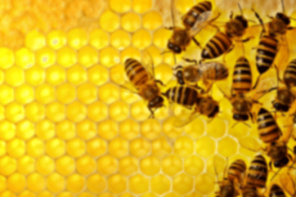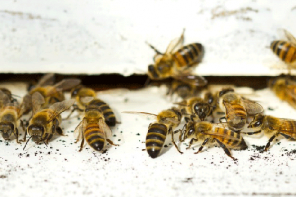Editorial By: Albert Chubak
Bullying is not only exhibited by young people, it may be the office jerk who you wish would just quit.
Bullying is a form of control where the instigator wants to usurp power or force an ideology on another person. Society as a whole sees differences as not necessarily bad, evil, or corrupt – just different. What is good for one is not always good for all. One thought, method, practice, an application is rarely universal as many situations can exist that need variation. In beekeeping, many think one system or practice or belief should be universal and should not be questioned. Many beliefs are shared in books written by those in the bee world that claim to be the “way it is.” However, beekeeping is a regional thing and adaptation to the environment, local conditions, personal limitations, and needs all play a part in what method, hive, system, or application is, will, or could be used. Regularly there are posts where the “all knowing” seasoned beekeeper will share his “word” on what should be followed in relation to a hive type. Many times, this insight is not wanted nor sought but comes and can be critical and demeaning. Bullying in any form is ignorant and short-sighted.
Historical development and where we are
There was a time beyond our days when the craft of beekeeping was excitingly new, and almost anything was accepted, tried, and even patented. Every thought, idea, method, and structure was detailed and submitted for a patent then labeled and accredited as a “patented beehive.” As the beekeeping ideas were tried, slowly some faded away, and are now lost. The victor in the battle of the 19th-century beehives was Lorenzo Langstroth’s hive. It was the simplest design with the greatest commercial potential. This hive though did not meet every beekeeping need then or now, so other systems and styles have evolved.
Joining an extended partially intolerant family – a family of beekeepers
Today there are about 800 beekeeping clubs nationally in the US. According to the USDA in October/December 2017 there were 3,032,060 commercial honey bee colonies in the United States (http://usda.mannlib.cornell.edu/MannUsda/viewDocumentInfo.do?documentID=1943). Hobbyists increase that total significantly. An estimate on the number of beekeepers in the USA is quite elusive but is believed to be between a half and two million.
Many beekeepers are private in how they manage their colonies, yet others are quite outspoken. The adage, “ask 10 beekeepers a question, you’ll get 10 answers,” is quite realistic. With the advent of social media, many have sought their beekeeping enlightenment via venues like YouTube and Facebook. Those joining the ranks of “beekeeper” initially view others as perhaps their new family. Comradery is expected, but for those who choose a variant system/hive, a door is opened that leads the beekeeper initially into defense mode. This defense is a result of ostracization, ridicule, and simply bullying. Instead of a welcoming hand or word of friendship, many are avoided as their choice of a hive is not the standard Langstroth hive, so clearly, they must be on an opposing beekeeping team!
The world of beekeeping is not all Langstroth’s world
Variant hives have always existed, with the most common 21st-century styles/methods being:
- Warre hive,
- Top-bar or Kenyan hive,
- Horizontal or Long-box hive,
- Flow Hive,
- Mini Urban Beehive,
- Slovenian hive,
- Barrel hive, bullet and others
Each hive system serves a specific need due to regional issues, or adaptation to a specific environment, local conditions, personal limitations, honey production, bee health, growth cycles, emotional, medical, diet, age, millennial status, ease or simplicity, and of course beauty. Those with variant hives seeking beekeeping answers may be bombarded with responses typical of the Langstroth method. Those loyal to this 19th century adaptation in beekeeping (Langstroth) may display almost religious zeal in defending their “hive” and opposing others as “second rate” or “novelties.” Another saying, “If you want to be a beekeeper, you need to do as the big boys do.” The beekeeper’s perceptional view window is stuck on one setting (hive), even though they agree many hives exist. It is narrow-minded to think one hive style can serve every need. Other needs exist besides HONEY.
When the “Flow” hive made its initial debut on social media, many traditional beekeepers were vehemently opposed to it while new beekeepers were mesmerized by it. Some of the hatred rose due to the horrendous amount of “hey look at this new hive” posting. Many traditionalists tried to mansplain the reasons why it was bad, evil, foolish without ever trying it. Not everything needs to be tried to expose faults. Experience can replace some testing but testing is the best route. Many reasons have been touted in opposition to this new hive system, but many have now successfully used it. Is it a perfect system? The answer is to be decided by the one using it. Years ago, we had rotary telephones and we loved them – longer cord the better. Today we have minicomputer style cell phones, and we love them despite their costs.
Basing a belief on a myth is like believing in a fairytale
- There are myths in beekeeping that are actually false but are promoted and taught by many.
- A colony needs 80lbs of honey to survive a Winter (Smaller colonies require less stores. Carniolan bees go through Winter with smaller colonies and can survive with less. Italian bees build up to large colonies that consume a great deal of resources even in Winter).
- You can’t start a colony without a queen (As long as there are nurse bees with eggs laid by a mated queen and available resources of pollen and honey, the colony can create a queen).
- All honey bees are aggressive (Defense bees are protective; nurse bees are non-aggressive).
- Plastic foundation is the only way to have perfect frames (Smaller frames with starter strips of thin surplus create perfect honeycomb).
- Only a double deep or equivalent hive can survive the Winter (Small colonies have survived the Winter in nature for millions of years. Methods and hives exist that prove this false).
- A swarm in May is worth a load of hay, a swarm in June is worth a silver spoon, a swarm in July isn’t worth a fly (Swarms can always be added to an existing colony. Double queened colonies also generate faster larger bee populations. Mini colonies can be started as late as October that survive the Winter).
- The size of the hive is equal to how much honey can be produced (Honey production is related to available forage and health of the colony. A smaller colony/hive can out-produce a larger colony/hive based on location, health, and age of queen).
- Only a three-lb package or a five frame Nuc can build a colony that can survive the Winter (Colonies started with as little as two 6”x6” frames of open brood with nurse bees in June cannot only create a locally mated queen but also survive Winter in any North American climate).
- Bees prefer a vertical hive compared to a horizontal hive (Many methods/hives exist globally, showing bees adapt to their chosen hive).
- Drawn wax takes lots of resources for a colony to produce (Wax is produced quickly when nectar is abundant. Inducing wax production can be facilitated by feeding both carbs and protein).
- One hive style is perfect for every application (Many needs exist for having honey bees ranging from medical apitherapy to apartment dwellers, to pollination gardens and seniors or children and those with handicaps. One size hive does not fit all needed applications).
- The best hive is the Langstroth hive. (There are many hives and each has pros and cons. The Langstroth hive is the best commercial hive as it is adapted to facilitate honey production and pollination. It is not, however, a great hive to learn on. It is heavy, requires extraction, utilizes plastic foundation, can be overwhelming to a new colony and beekeeper).
Learning how to be kind to one another, an art social media decimated
The true teacher understands a student may learn in many ways, one of them is in failure. Failure is a powerful teaching experience. It is also vital that the teacher first learns about the item in question. Speaking generally about beekeeping is a broad topic, whereas speaking about a specific method requires an understanding of that method. To teach requires kindness and tact like the powerful saying, “If you don’t have anything good to say, don’t say nothing at all.”
According to Karanveer Pannu, the number one cause of bullying is ignorance. www.theodysseyonline.com/detrimental-consequence-ignorance-lack-education
Other suggested guidelines to prevent beekeeping bullying online or otherwise:
- Do not speak down to the person or use derogatory comments.
- If you do not have specific understanding related to the item discussed, say nothing at all.
- First, seek to understand the needs of the individual.
- Suggest where information can be obtained, if known.
- Refrain from mansplaining or trying to redirect to a personal agenda.
- Understand many views can be right, but the missing key may be what “they” want, not you.
- You may not know everything about beekeeping, even though you are a beekeeper, that is okay.
- Sometimes helping may be just listening.
- Understand the question before you respond.
- Keep your personal feelings to yourself.
- Avoid manipulation, as it is the act of intentionally trying to redirect to your way of thinking.
- If related to the Internet, know many may see your comments besides those in the discussion.
A recent discussion on a Facebook site was initiated by a new beekeeper wanting access to bees. Instead of specific help solving her issue, discourses followed relating to the “poor” choice of beekeeping equipment. In the end, a personal response was sent via private message “Looks like I am now hated by my new friends.” As referenced earlier, do we “eat our own” or do we nurture them to succeed despite what we think is good for them?
Albert Chubak owns and runs Eco Bee Box in West Valley City, UT.







